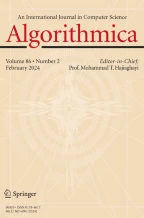Abstract
The traditional worst-case analysis often fails to predict the actual behavior of the running time of geometric algorithms in practical situations. One reason is that worst-case scenarios are often very contrived and do not occur in practice. To avoid this, models are needed that describe the properties that realistic inputs have, so that the analysis can take these properties into account.
We try to bring some structure to this emerging research direction. In particular, we present the following results:
• We show the relations between various models that have been proposed in the literature.
• For several of these models, we give algorithms to compute the model parameter(s) for a given (planar) scene; these algorithms can be used to verify whether a model is appropriate for typical scenes in some application area.
• As a case study, we give some experimental results on the appropriateness of some of the models for one particular type of scene often encountered in geographic information systems, namely certain triangulated irregular networks.
Similar content being viewed by others
Author information
Authors and Affiliations
Rights and permissions
About this article
Cite this article
de Berg, van der Stappen, Vleugels et al. Realistic Input Models for Geometric Algorithms . Algorithmica 34, 81–97 (2002). https://doi.org/10.1007/s00453-002-0961-x
Issue Date:
DOI: https://doi.org/10.1007/s00453-002-0961-x
